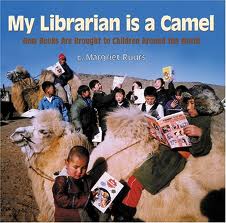
Introduces the many ways books are delivered to readers in different countries around the world, including by camel, bicycle, and wheelbarrow.
Related: Nonfiction, Primary (ages 6-9)
- ISBN: 9781590780930
- Author: Ruurs, Margriet
- Published: 2005
- Themes: Sisters
- Descriptors: Nonfiction, Primary (ages 6-9)

Ann Parker
I had tears in my eyes while I was reading this book, because it is such a testament to the power that books and learning have in people’s lives, from the people who go to such lengths to bring books to children to the children themselves who literally live for the next library visit, just like little Ana in Monica Brown’s book Waiting for the Biblioburro.
Margriet Ruurs explains in her prologue that she became interested in learning about all the ways that books and children come together when she read an article in a Kenyan newspaper about camels bringing books to children in remote areas. She became interested in unique libraries around the world that bring kids and books together, and put the stories together into a book. From camels (Kenya) to elephants (Thailand), boats (Finland and Indonesia) to wheelbarrows (England), through the mail (Canada) and by burro, horse, bus, and even on foot (in Papua New Guinea, volunteers walk for four hours through the jungle to bring boxes of books to an isolated village), the dedication of these librarians and the excitement of the children is truly inspiring.
I also like the fact that she includes information on each page about the country itself, providing a mini geography lesson to students.
I especially liked the section on Mongolia, where the librarians use a minibus to travel to children in the Gobi desert. The program is called Amttai Nom, “candy books”, because in addition to books the children also get food and sweets. When the librarian asks the kids if the books or candy was sweeter, the children yell “Books!” What can be sweeter than that?
Patricia Castrodad
I agree with Ann in that as you read there are interesting facts that evoked in me to know more about the country that I was reading about. But, what caught my attention was the different ways in which children and librarians responded to having books or story telling like in Pakistan in their communties. For example, in Indonesia, children are “excited about rummaging through a new box of books to read,” “Liza is excited to find good picture books in the package,” Canada, children of Bulla Iftin (Kenya) “await eagerly the arrival of the camels,” “children…are excited about browsing through books when they arrive, are turning to avid readers,” Peru, “older readers want books on farming,” Zimbabwe. Most of all, as Travis a librarian in Australia says, “Some stories leave children with something to think about, other bring laughter or tears….”
Not only I enjoyed this part but also think it is important to capture, as in this book, the importance of books and diversity in children’s, librarians . . . peoples’ lives. We learn through reading (having books in our lives) to collaborate (organize books), creativity, empathy, solidarity, patience…peace.